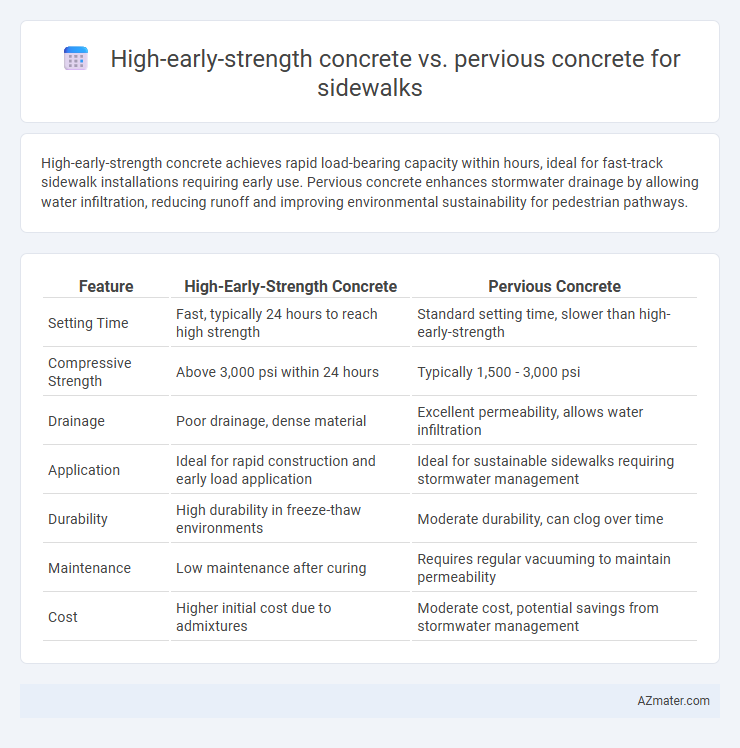High-early-strength concrete achieves rapid load-bearing capacity within hours, ideal for fast-track sidewalk installations requiring early use. Pervious concrete enhances stormwater drainage by allowing water infiltration, reducing runoff and improving environmental sustainability for pedestrian pathways.
Table of Comparison
| Feature | High-Early-Strength Concrete | Pervious Concrete |
|---|---|---|
| Setting Time | Fast, typically 24 hours to reach high strength | Standard setting time, slower than high-early-strength |
| Compressive Strength | Above 3,000 psi within 24 hours | Typically 1,500 - 3,000 psi |
| Drainage | Poor drainage, dense material | Excellent permeability, allows water infiltration |
| Application | Ideal for rapid construction and early load application | Ideal for sustainable sidewalks requiring stormwater management |
| Durability | High durability in freeze-thaw environments | Moderate durability, can clog over time |
| Maintenance | Low maintenance after curing | Requires regular vacuuming to maintain permeability |
| Cost | Higher initial cost due to admixtures | Moderate cost, potential savings from stormwater management |
Introduction: Comparing High-Early-Strength and Pervious Concrete Sidewalks
High-early-strength concrete achieves rapid compressive strength gain, enabling quicker curing and early opening of sidewalks to pedestrian traffic, ideal for projects requiring fast turnaround. Pervious concrete reduces surface runoff by allowing water infiltration, improving stormwater management and minimizing urban flood risks along sidewalks. The choice between these concrete types depends on balancing construction speed with environmental sustainability and drainage requirements in urban design.
Material Composition of High-Early-Strength Concrete
High-early-strength concrete for sidewalks typically consists of a higher cement content, often using Type III Portland cement, combined with fine aggregates and chemical admixtures like accelerators to speed up hydration and achieve rapid strength gain. This mix design emphasizes low water-cement ratios and optimized particle packing to enhance early compressive strength, allowing for faster project turnaround and early load-bearing capacity. In contrast, pervious concrete uses a coarser aggregate skeleton with minimal fines to create interconnected voids for water permeability but does not prioritize early strength development.
Material Composition of Pervious Concrete
Pervious concrete for sidewalks consists primarily of coarse aggregate, cement, water, and minimal fine aggregates, creating a porous matrix that allows water infiltration, contrasting with the denser mix of high-early-strength concrete which emphasizes rapid strength gain. The open-graded structure of pervious concrete typically incorporates 70-80% coarse aggregate by volume and a low cement paste content around 8-12%, promoting permeability and stormwater management. This unique material composition supports sustainable urban development by reducing runoff and improving groundwater recharge compared to the less permeable high-early-strength concrete.
Strength and Durability Characteristics
High-early-strength concrete achieves rapid load-bearing capacity, typically reaching 70% of its ultimate strength within 24 hours, making it ideal for quick-turnaround sidewalk projects requiring early traffic opening. Pervious concrete, designed with high interconnected porosity, exhibits lower compressive strength, commonly ranging between 2,500 to 4,000 psi, but offers superior permeability and stormwater management benefits. Durability in high-early-strength concrete is enhanced by reduced microcracking and improved freeze-thaw resistance, whereas pervious concrete requires careful maintenance to prevent clogging and deterioration due to debris infiltration, impacting its long-term structural integrity.
Permeability and Drainage Capabilities
High-early-strength concrete offers rapid curing and high compressive strength, but its low permeability limits water drainage, making it less effective for managing surface runoff in sidewalks. Pervious concrete features interconnected pore spaces that enable superior permeability, facilitating efficient stormwater infiltration and reducing water accumulation on pedestrian pathways. The enhanced drainage capabilities of pervious concrete contribute to improved environmental runoff management and minimize hydroplaning risks compared to high-early-strength concrete.
Construction Speed and Curing Time
High-early-strength concrete achieves compressive strength rapidly, typically reaching 3,000 psi within 24 hours, enabling sidewalk construction to progress quickly with minimal curing delay. Pervious concrete, designed for water permeability, requires longer curing periods--often 7 to 28 days--to ensure structural integrity while maintaining porosity. The accelerated curing and strength gain of high-early-strength concrete significantly reduce construction time compared to the extended curing demands of pervious concrete for sidewalks.
Environmental Impact and Sustainability
High-early-strength concrete achieves rapid strength gain by utilizing higher cement content and chemical admixtures, which often results in increased carbon emissions and resource consumption compared to pervious concrete. Pervious concrete promotes sustainability by allowing water infiltration, reducing stormwater runoff, and enhancing groundwater recharge, thereby mitigating urban heat island effects and lowering the risk of flooding. While high-early-strength concrete is advantageous for fast construction, pervious concrete offers superior environmental benefits through improved water management and reduced ecological footprint.
Maintenance Requirements and Lifespan
High-early-strength concrete offers rapid curing and enhanced durability, requiring minimal maintenance with resistance to cracking and freezing. Pervious concrete facilitates water drainage, reducing surface runoff and preventing puddles, but demands regular cleaning to maintain permeability and prevent clogging. The lifespan of high-early-strength concrete typically extends beyond 30 years under proper conditions, whereas pervious concrete generally lasts 15-25 years depending on maintenance frequency and environmental factors.
Cost Analysis and Economic Considerations
High-early-strength concrete offers rapid curing times, reducing labor and formwork costs, which is beneficial for sidewalks in high-traffic areas requiring quick reopening; however, its material costs are typically higher than traditional mixes. Pervious concrete, while potentially lowering stormwater management expenses by reducing the need for separate drainage infrastructure, can have increased maintenance costs due to clogging and reduced durability under heavy loads. Economic considerations must balance the upfront costs of high-early-strength concrete against the long-term savings from pervious concrete's environmental benefits and regulatory incentives.
Best Applications: Choosing the Right Concrete for Sidewalks
High-early-strength concrete is ideal for sidewalks requiring rapid construction and early load-bearing capacity, such as in busy urban areas or commercial zones with heavy foot traffic. Pervious concrete is best suited for environmentally sensitive applications where stormwater management and groundwater recharge are priorities, like in parks or residential neighborhoods with strict runoff regulations. Selecting the right concrete depends on balancing the need for quick usability and durability against sustainability and drainage benefits.

Infographic: High-early-strength concrete vs Pervious concrete for Sidewalk
 azmater.com
azmater.com